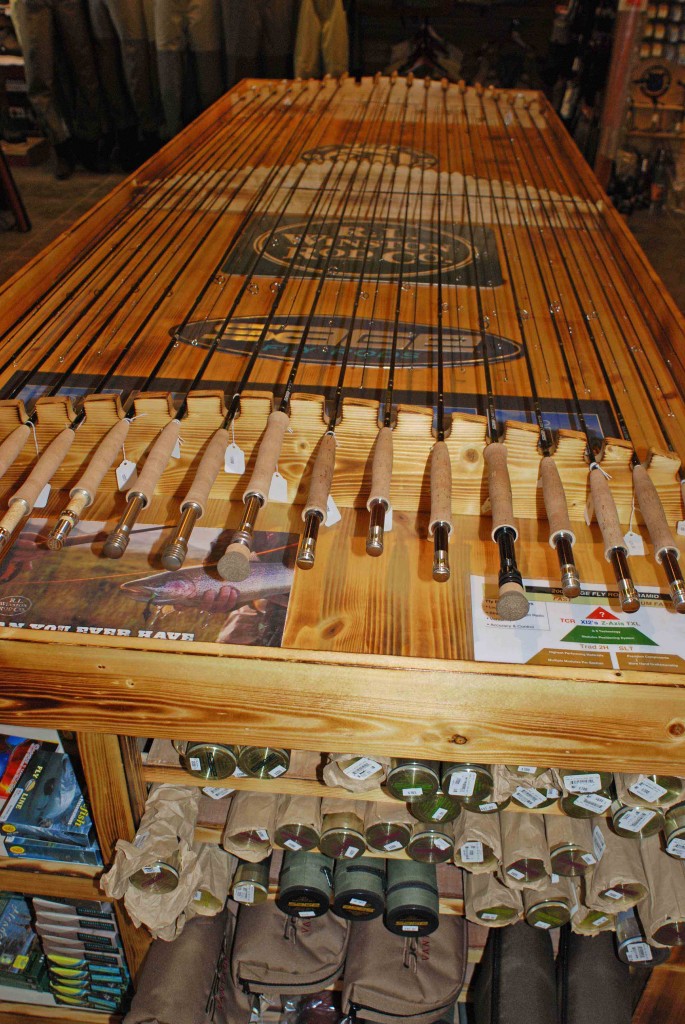Bighorn River Fly Rod Chronicles

Fly rod selection is an interesting science, or maybe “science” is too logical a word. So what constitutes the ideal Bighorn River fly rod? It all depends.
Almost everybody knows that fly rods have different line weight designations. Line weights 4, 5, 6 & 7 are most applicable for this river. I often tell customers to bring a 4 or 5 weight rod for the dry fly fishing, and a 6 weight rod for the nymph fishing. Having two rods rigged for both methods saves a lot of time—you don’t have to cut off your nymph setup if you encounter a pod of rising fish.
Fly rods come in different “actions,” generally categorized as slow, medium, and fast. Rod action is an umbrella term that tells you something about the way the rod bends. “Slow” indicates a rod that bends or flexes down into the rod butt, while the bend of a fast action rod is restricted primarily to the tip section. A fast-action rod generally feels stiffer in the hand than a slow-action rod, but there is no objective standard among manufacturers, and the fast-action rod of one company might be stiffer and heavier than the fast-action rod of another company. I could dive in here and attempt to give an in-depth explanation of all this, but there are a number of articles on the web which delve into the subject. So for now, I’ll try to keep things simple.
The Bighorn Trout Shop carries rods from several manufacturers. A medium-fast rod action seems to be the most versatile for our needs here on the river. Over the last five years, our best selling model line has been the Winston Boron IIx. This is for good reason. This rod is very light in the hand, has a smooth, medium-fast action, and seems to strike the right balance between fishability and castability. By that, I mean this rod has enough backbone to throw a lot of line and punch a cast into the wind, plus it loads well at short distances and mends line well. It is also flexible enough in the tip section to protect light tippets. I own the 9’ 4 wt. BIIx, which is my primary dry fly rod. I also use the 9 ½ ft. 6 wt. for most of my streamer fishing. The 9’ 5 wt. is our best selling rod, and truly an outstanding all-around performer.
The Sage ZXL is a model line that can do the same things as the Boron IIx. This rod has a slightly faster action than the Winston and is slightly heavier per line weight. I assume this is because Sage builds their rods with slightly more wall thickness in the blank. This is something to think about when you buy a fly rod: a manufacturer may be able to make a lighter rod, but there comes a point where durability is sacrificed. The ZXL is an excellent rod with a smooth, medium-fast action, plus it has a little more backbone than the Winston BIIX. It’s a great rod for both dries and nymphs, and it’s one of my personal favorites. However, if you really want a dedicated nymphing rod, one that can really chuck some lead and throw streamers in the wind, the Sage Z-Axis might serve you better. A few years back, during a stretch of high water here on the Bighorn, I found the Z-Axis to be the superior performer over the Winston BIIx when it came to chucking the heavy lead necessary in getting our nymphs to the bottom. It simply had the backbone to “get it done” and to do so comfortably. And as a streamer rod, it is amazing. It generates very high line speeds, which is perfect for pitching those cone-headed buggers or double bunnys.
The rods mentioned above are premium fly rods which come with a premium price. You are paying for the ultimate in basic rod design, high-modulus graphite, resin technology, and cosmetics. For those of you on a budget, however, there are a number of rods that will serve your purposes. Almost all the premium rod manufacturers, Sage, Winston, Loomis, etc., make lower-priced models that are wonderful fishing tools. And Redington, Ross, St. Croix, Echo, Hardy, and Temple Fork all make wonderful fishing tools for $300.00 or less. The St. Croix Imperial is a personal favorite, but you won’t be disappointed with the others. I keep at least one of these rods around for my “boat rod” while I’m guiding. They work just fine, and I don’t weep openly if somebody steps on them. (I weep privately.)
Fly rod quality is at an all-time high. If you do just a little research, you should have no problem finding a product that suits your fishing requirements and budget. Give us a call here at the Bighorn Trout Shop if you have questions. Montana doesn’t have a sales tax, so you can save some money. By the way, the word on the street (steam?) is that later this year, two rod companies will be utilizing the new nano technology to build fly rods which are superior to what is currently available. You may have to put your old rods on Ebay because I’m sure the Bighorn Trout Shop will be carrying them. ☺